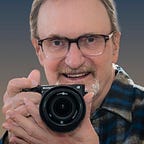“The negative is the equivalent of the composer’s score, and the print the performance.” — Ansel Adams
I Love All My Photos (Too)
Inspired by Dave Sharpe
Dave Sharpe published this piece recently:
Dave made me stop! And think! He inquired,
Do you publish any which you’re not entirely happy with?
I answered, Never.
That’s true. I am a technician, a documentarian, and a “photovore.” I am also a “sharp freak.” It’s my first criterion during a cull: if it ain’t sharp, it gets binned. If I don’t like it, you will never see it, except perhaps as a good example of bad. I’m a skilled photographic mechanic. I don’t think I have much imagination or creativity, but I try. I hope I am improving, growing, developing (pun fully intended), and making incremental progress toward some elusive photonirvana. (?)
Take a scroll through Dave’s pictures. They are robustly abstract, quirky, impeccably composed and finished. I see why he loves them — I love them too.
But then I questioned whether I love or even like my stuff. On reflection, I am pleased to tell you, I do! While no artiste, thirty years in darkrooms shows in my work. I love craft. I love editing and finishing. I love what I can do today that I could not do yesterday, never mind forty years ago. I love my pictures, at least enough to share them, which I wouldn’t if I didn’t love them.
I’ve written often about my ~60,000 files that I still enjoy going back to rework with my ever-growing combination of tools and techniques. Now we have (so-called) Artificial Intelligence making more of the once-impossible, possible, and so seamlessly that some of it is scary.
I could be accused of being the “lazy” photographer, “that” guy who sprays and prays assuming he can “fix it” in post.
I resent that.
I know compositional balance. I insist (as much as humanly possible) on accurate exposure. As a RAW guy, I ETTR (Expose To The Right) — within reason; a little experimentation discovers how far is too far. I hate it when I lose detail in clouds. It’s a thing. But I will push the envelope as far as I dare for better shadow detail with less noise, but that’s not the end.
I “fix” it in post all the time, and I have ever since I took my first digital photo in 2007. I had a copy of Adobe Photoshop Elements 2.0 and used it. Post-processing is part of the art. I firmly believe the SOOC (Straight Out Of Camera) image is less than half the picture. The real artistry and creativity lie in good, really good editing and post-processing. I have even ranted from time to time that “Get It Right in the Camera” is a myth. It implies that you can shoot JPEGs that are so perfectly crafted in-camera by precise and learned manipulation of the holy exposure triangle that nothing beyond what the soulless algorithm mysteriously does in the camera is needed. (Are we looking at the same picture?)
Bluntly, I say hogwash. Saying so has gotten me in trouble, and the bottles and brickbats fly:
You are too lazy to Get It Right in the Camera!
Oh, yeah? YOU are too lazy to learn to properly post-process!
Ya mudder wears combat boots!
Come over here and say that (she does, actually…Marines).
You can’t have a calm, reasonable discussion with fanatics.
“Dodging and burning are steps to take care of mistakes God made in establishing tonal relationships.” — Ansel Adams
If you know of Saint Ansel, you know that he spent a lifetime becoming one of the giants of 20th-century landscape photography, but have you ever seen a straight print from one of his most celebrated negatives?
Click on them to enlarge them. The two prints speak for themselves. Adams, in fact, didn’t “get it right in the camera,” but not because he wasn’t trying. Still, he knew there was no such thing. He began with a good negative (and Moonrise wasn’t one of them!), then went into the darkroom for days and nights of test swatches and prints and blood, sweat, tears, bloodshot eyes, stained shirts, and notebooks filled to overflowing to arrive at what he had previsualized when he made the initial exposure.
I swore I wouldn’t clutter this piece up with what I have been told were “too many pictures,” but I am a visual person. I need to show examples. We are talking about pictures, amirite? I can’t talk about pictures without, um, pictures.
Like many, I suffer from Imposter Syndrome. I avoid making rigid statements such as “you must” or “if you are not — (you are doing it wrong)” because I know I could be wrong. I’ve lived long enough to grok that there really is more than one way to skin the unfortunate proverbial cat. I often quote myself, “Ya do wot works.” It’s even a little uncomfortable for me to say out loud, “I love my photos,” so thanks, Dave, for giving me permission to tootle my muted horn a bit. It’s refreshing!
📸As always, gratitude for looking in. I sincerely appreciate it! 😊👍
EDIT
Felix John Attard’s eye was as attracted to Dave’s (Davíð S. Matthías) piece as I was. Read his response above.
